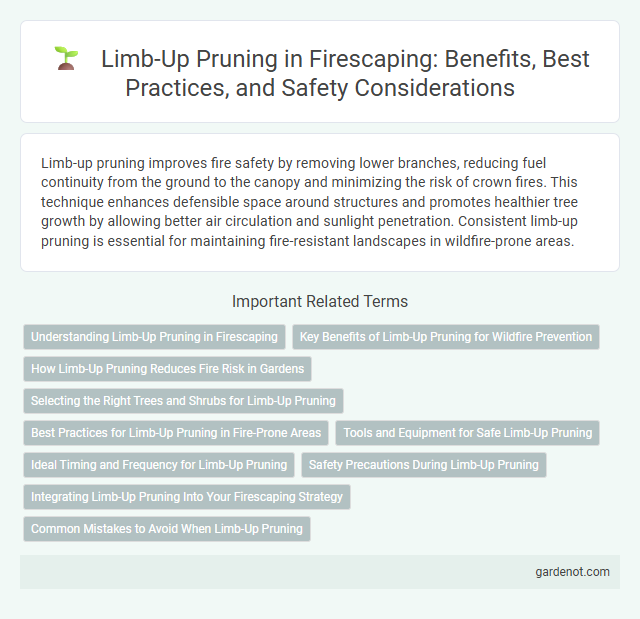Limb-up pruning improves fire safety by removing lower branches, reducing fuel continuity from the ground to the canopy and minimizing the risk of crown fires. This technique enhances defensible space around structures and promotes healthier tree growth by allowing better air circulation and sunlight penetration. Consistent limb-up pruning is essential for maintaining fire-resistant landscapes in wildfire-prone areas.
Understanding Limb-Up Pruning in Firescaping
Limb-up pruning in firescaping involves selectively removing lower branches of trees to create vertical clearance, reducing fuel on the ground and minimizing fire spread potential. This technique enhances defensible space by preventing ground fires from climbing into the tree canopy, thus protecting structures and surrounding vegetation. Proper limb-up pruning maintains tree health while strategically lowering fire risk in wildfire-prone areas.
Key Benefits of Limb-Up Pruning for Wildfire Prevention
Limb-up pruning enhances wildfire prevention by removing lower tree branches, reducing fuel continuity and limiting ground fire spread into the canopy. This practice improves defensible space around homes, allowing firefighters easier access and safer conditions during wildfire events. By increasing vertical clearance, limb-up pruning helps slow fire intensity, protecting property and natural ecosystems.
How Limb-Up Pruning Reduces Fire Risk in Gardens
Limb-up pruning removes lower tree branches, creating vertical space between the ground and the canopy, which reduces the potential fire ladder effect. By eliminating these fire ladders, flames cannot easily climb from grasses or shrubs into the tree canopy, thus minimizing the spread and intensity of fires. This method effectively decreases fire risk by interrupting the continuous fuel path within garden landscapes.
Selecting the Right Trees and Shrubs for Limb-Up Pruning
Selecting the right trees and shrubs for limb-up pruning involves choosing species with strong, well-spaced branches and high clearance to improve safety and aesthetics near structures. Deciduous trees like maples, oaks, and elms, as well as evergreen species such as pines and junipers, respond well to limb-up pruning due to their growth habits. Proper selection enhances fire resistance by reducing ladder fuels and minimizing dense lower foliage that can ignite.
Best Practices for Limb-Up Pruning in Fire-Prone Areas
Limb-up pruning involves selectively removing lower branches to create vertical clearance between the ground and the tree canopy, reducing fire intensity near structures. Best practices include pruning branches at least 6 to 10 feet high, ensuring cuts are clean to preserve tree health, and maintaining a safe distance from power lines and buildings. Regular maintenance of limb-up pruned trees enhances defensible space, minimizes ladder fuels, and improves overall fire resilience in fire-prone landscapes.
Tools and Equipment for Safe Limb-Up Pruning
Using sharp, ergonomic pruning saws and pole pruners ensures precise cuts during limb-up pruning, reducing tree damage and promoting healthy growth. Protective gear such as gloves, safety goggles, and helmets shield against debris and accidental injuries, while sturdy ladders or climbing harnesses provide stability when working at height. Regular maintenance of equipment, including blade sharpening and securing loose parts, enhances safety and efficiency throughout the pruning process.
Ideal Timing and Frequency for Limb-Up Pruning
Limb-up pruning is ideally performed during the tree's dormant season, typically late winter to early spring, to minimize stress and reduce the risk of disease. Trees should be pruned every 2 to 3 years, depending on growth rate and desired clearance, to maintain a healthy structure and improve fire safety by removing lower branches that can act as "ladder fuels." Consistent limb-up pruning enhances air circulation, reduces fire intensity near building zones, and promotes overall tree health.
Safety Precautions During Limb-Up Pruning
Limb-up pruning involves removing lower tree branches to reduce fire hazards by creating defensible space and improving visibility for firefighting efforts. Safety precautions include wearing protective gear such as gloves, eye protection, and helmets to guard against falling debris and sharp tools. It is essential to use proper pruning techniques with sharp, well-maintained tools to prevent injury and avoid damaging the tree, while also ensuring a stable footing to reduce the risk of falls during the process.
Integrating Limb-Up Pruning Into Your Firescaping Strategy
Integrating limb-up pruning into your firescaping strategy enhances fire prevention by removing lower tree branches that can act as fuel ladders, reducing the risk of ground fires spreading to the canopy. This technique promotes healthier tree growth and improves defensible space around structures by maintaining a vertical separation between vegetation layers. Consistently applying limb-up pruning within a firescaping plan optimizes landscape resilience and minimizes potential wildfire damage.
Common Mistakes to Avoid When Limb-Up Pruning
Limb-up pruning commonly suffers from over-thinning, which exposes trunks to sunscald and stress. Removing too many lower branches reduces the tree's ability to photosynthesize, weakening overall health. Avoid cutting flush with the trunk to prevent bark damage and increase the risk of disease entry.
Limb-up pruning Infographic

 gardenot.com
gardenot.com